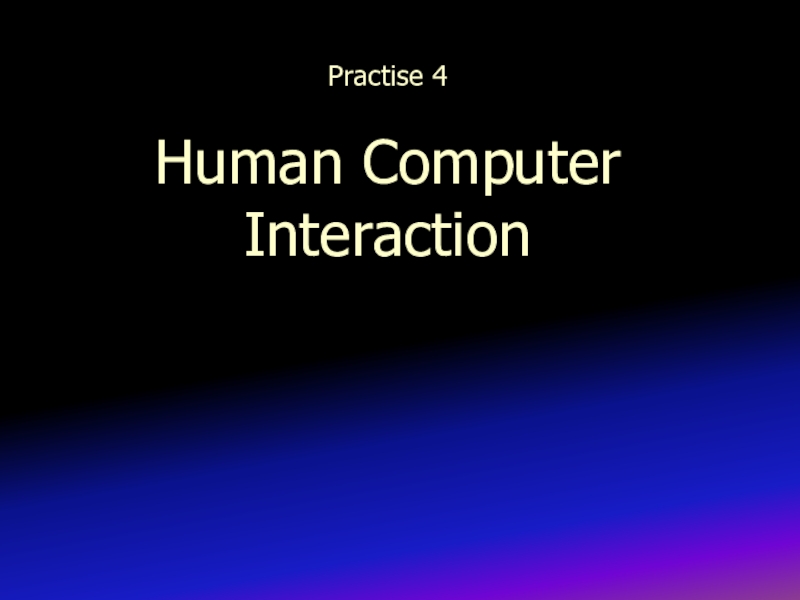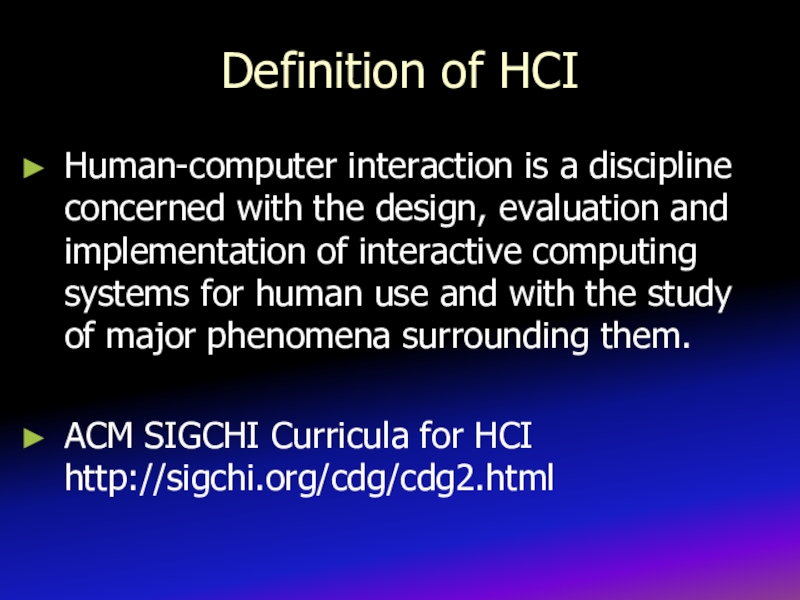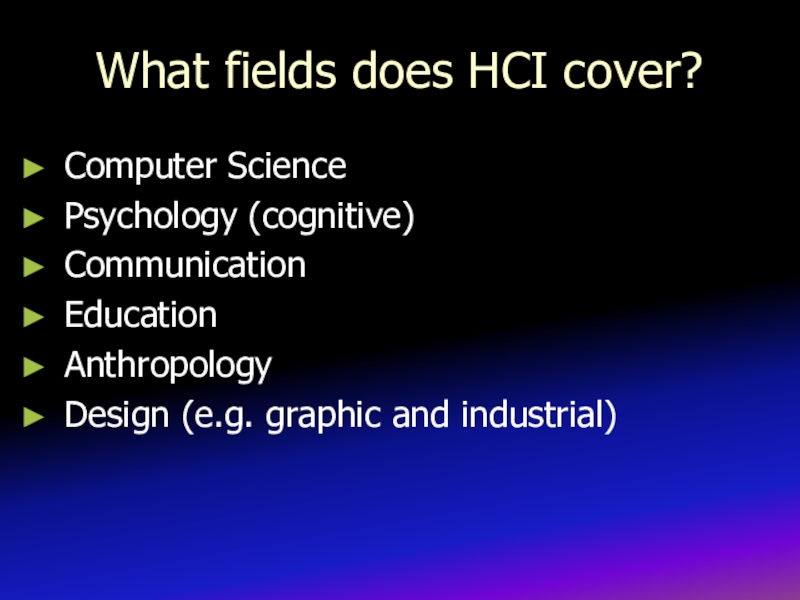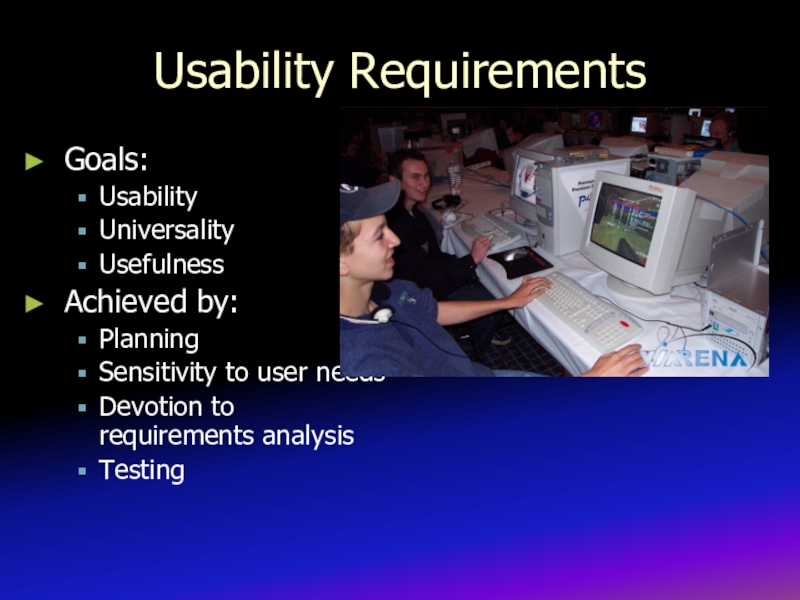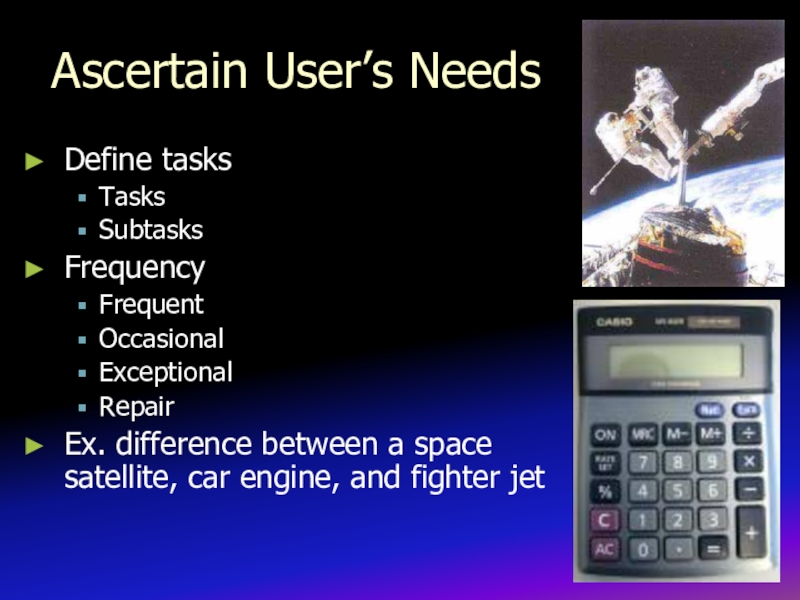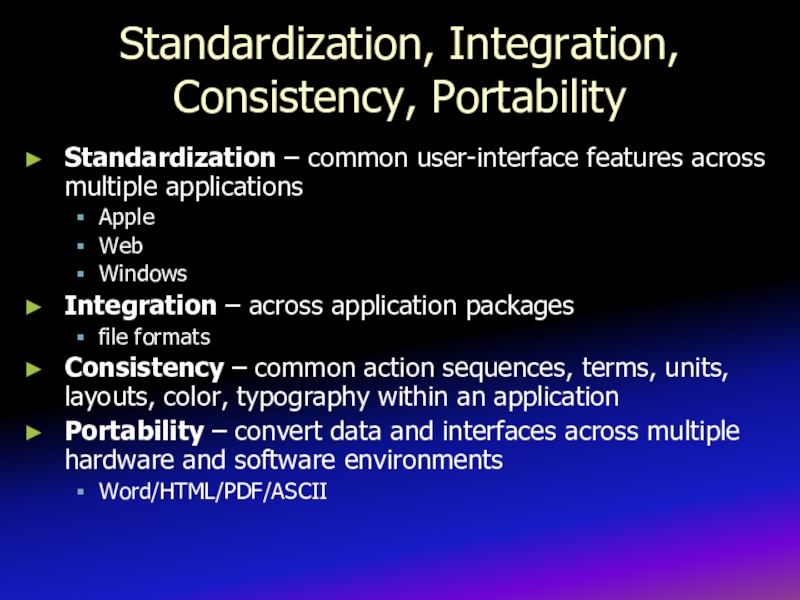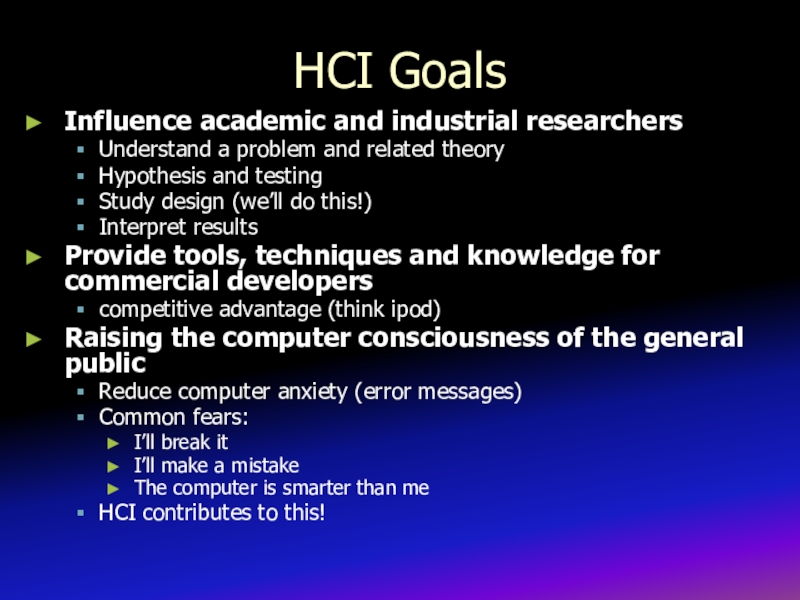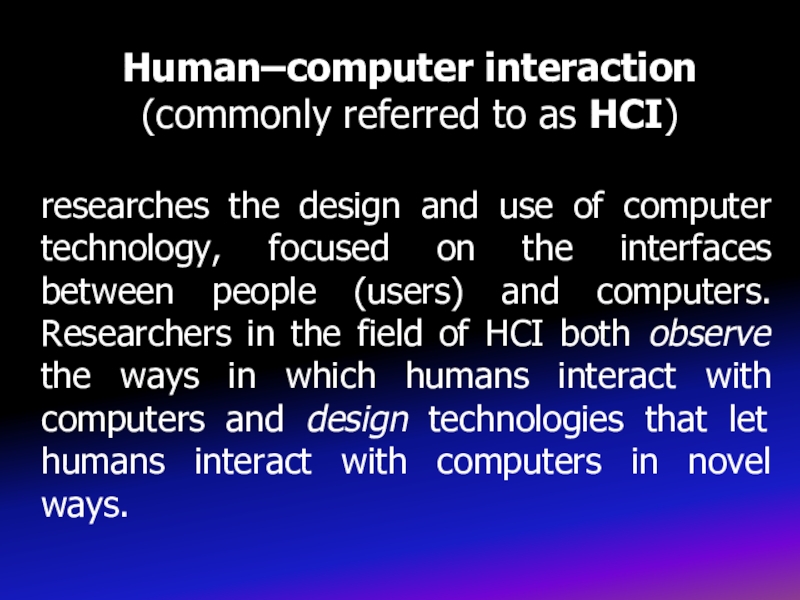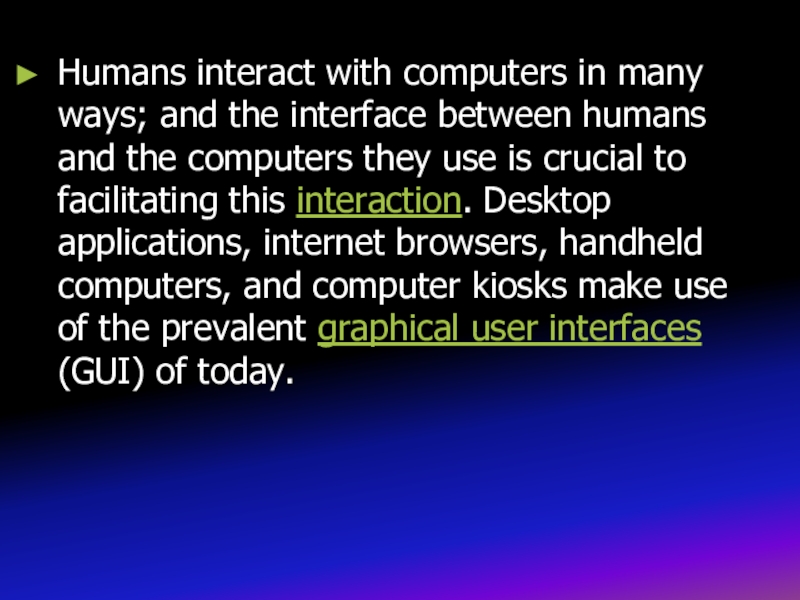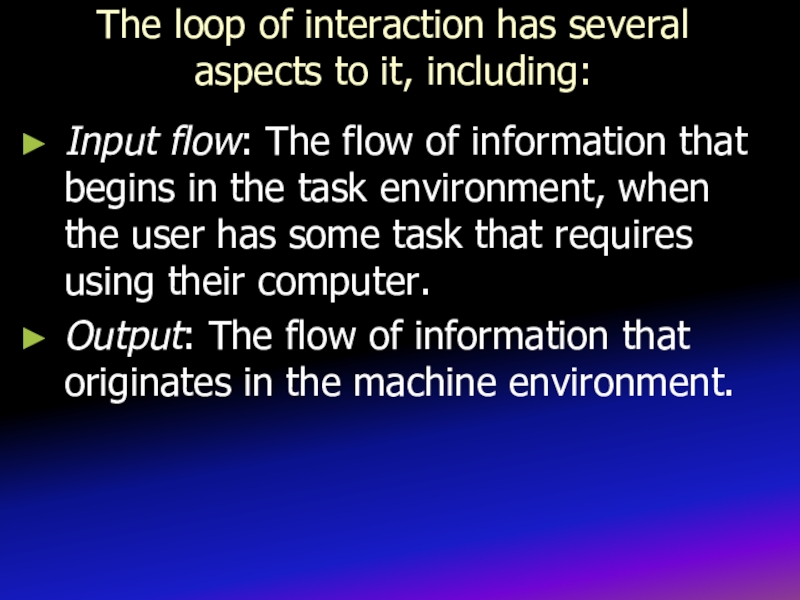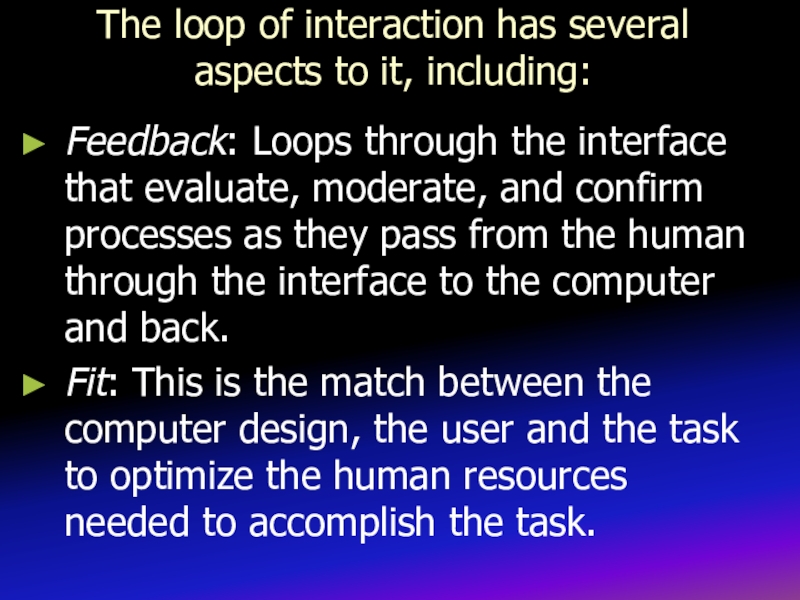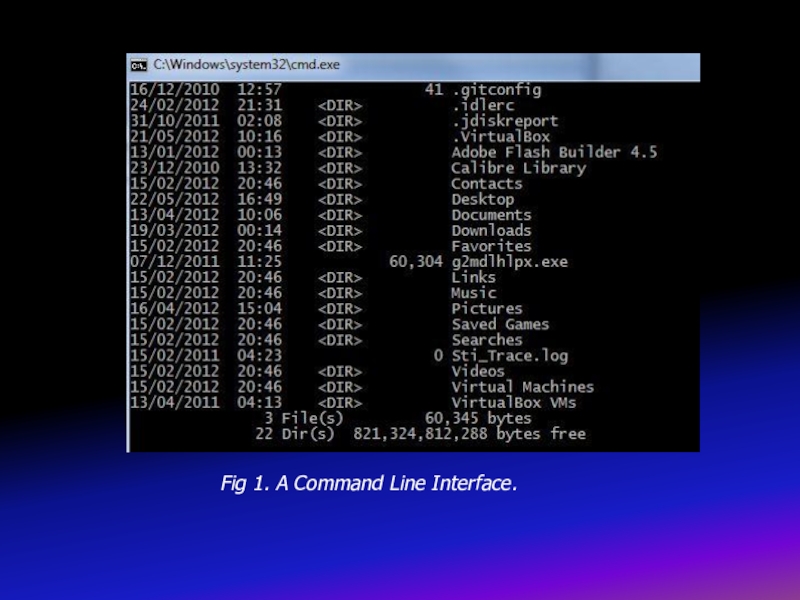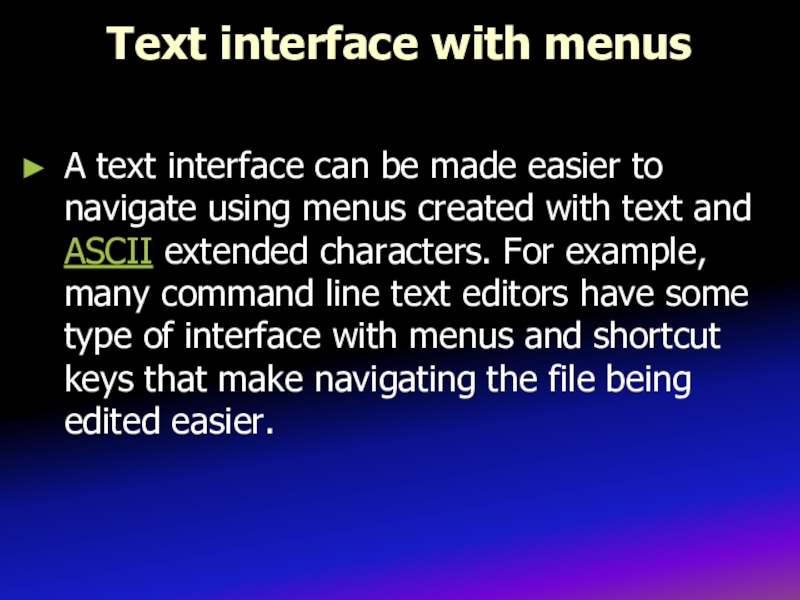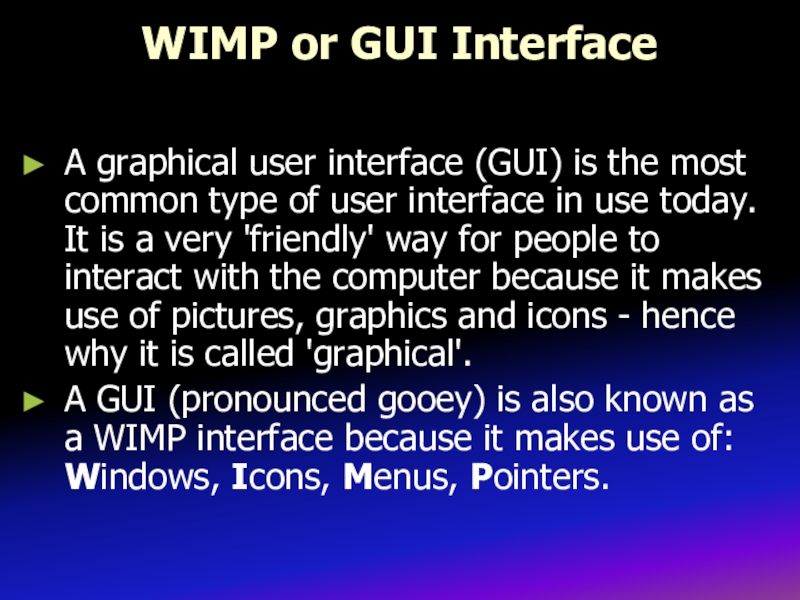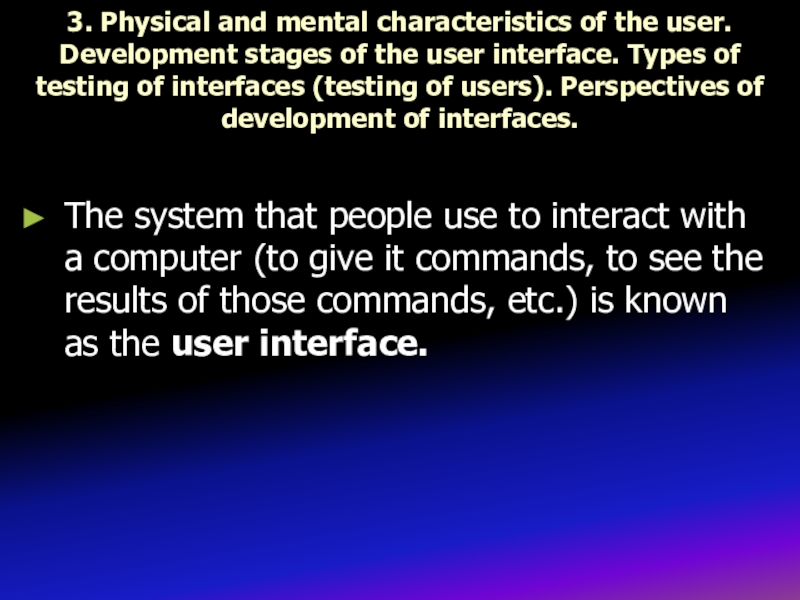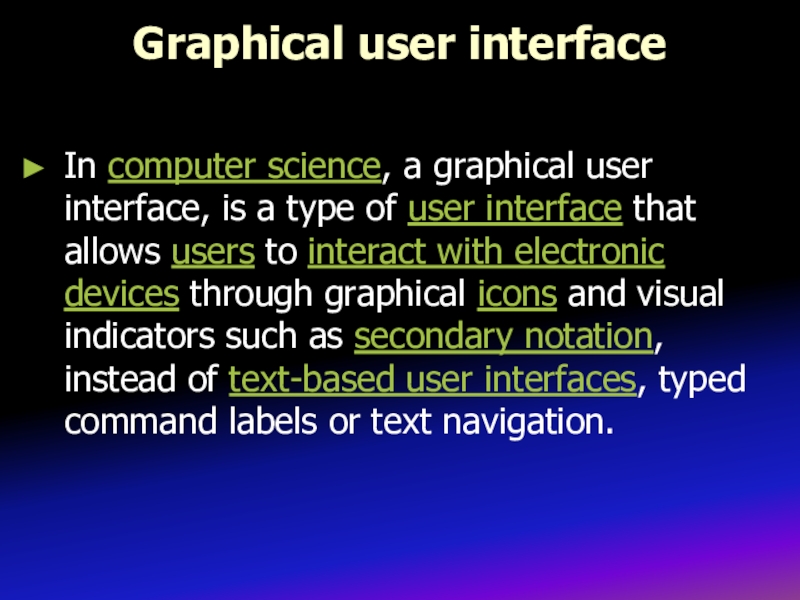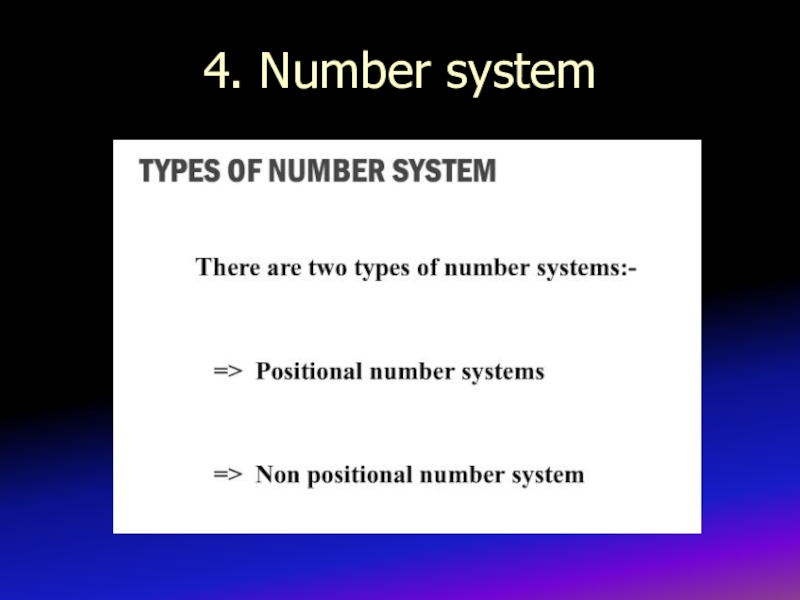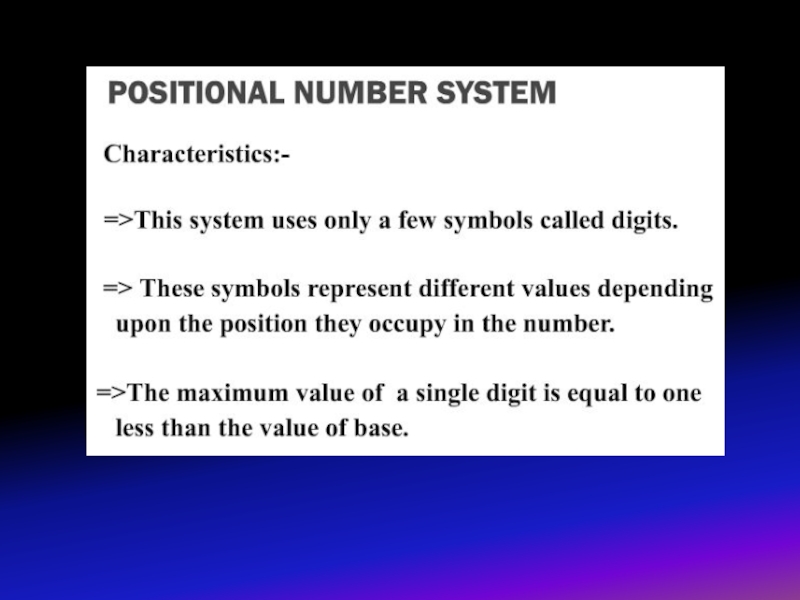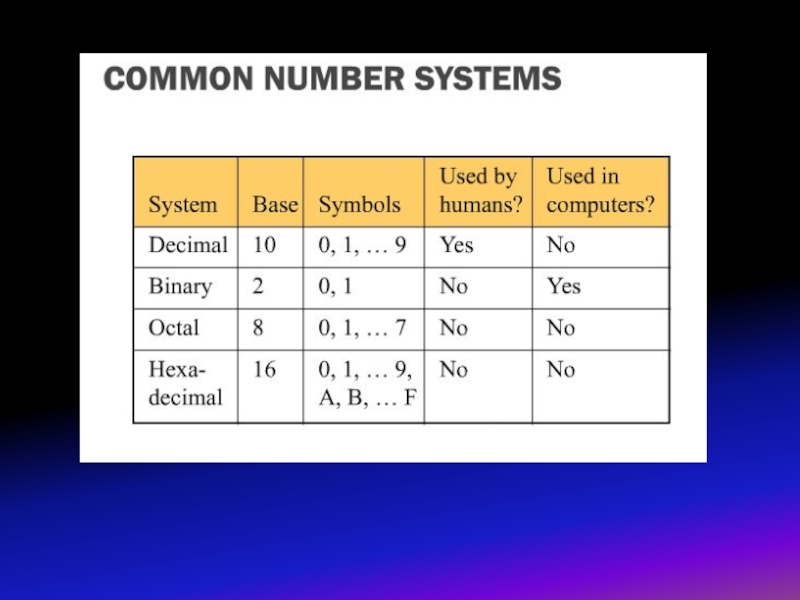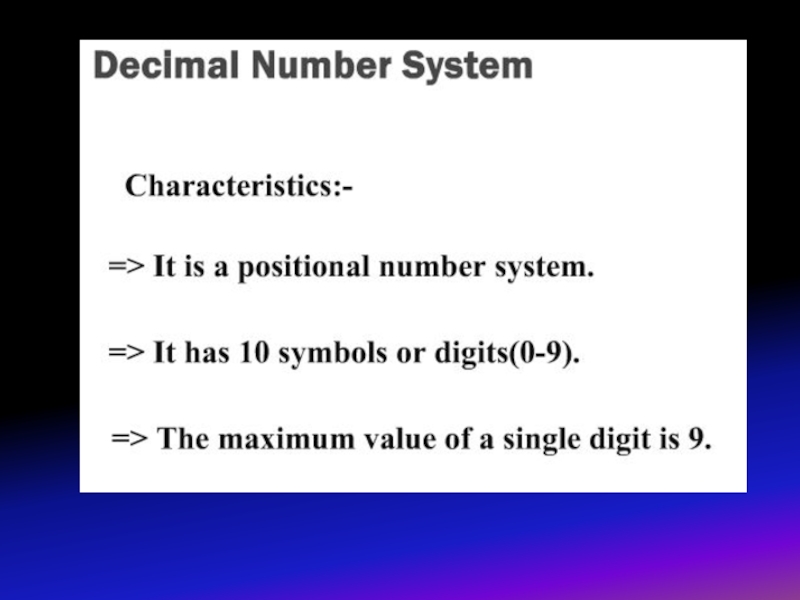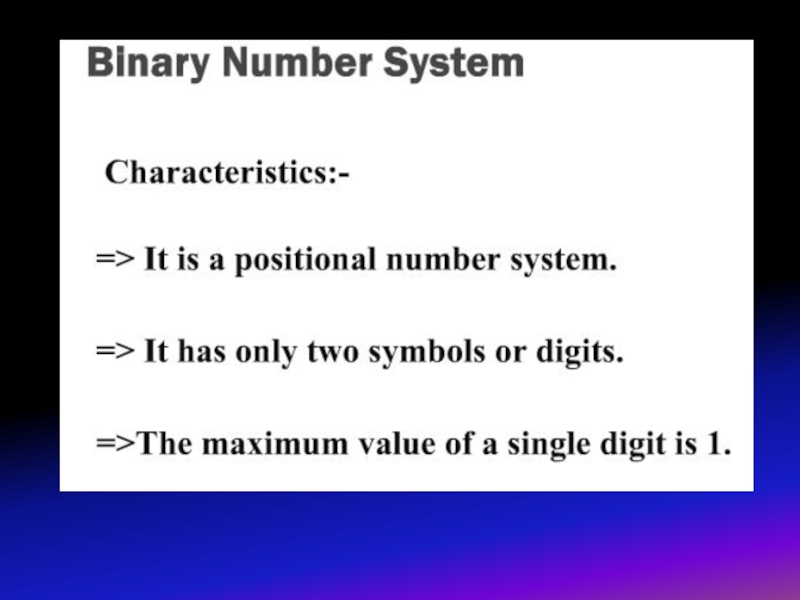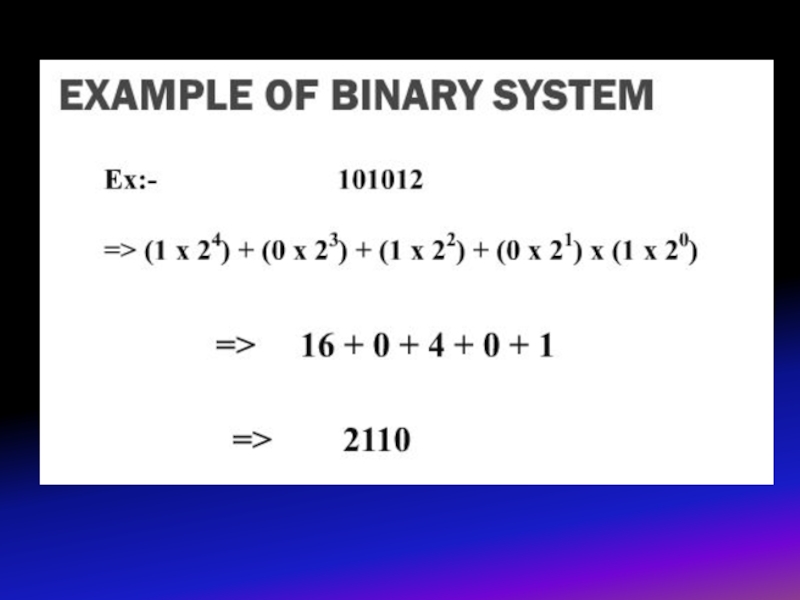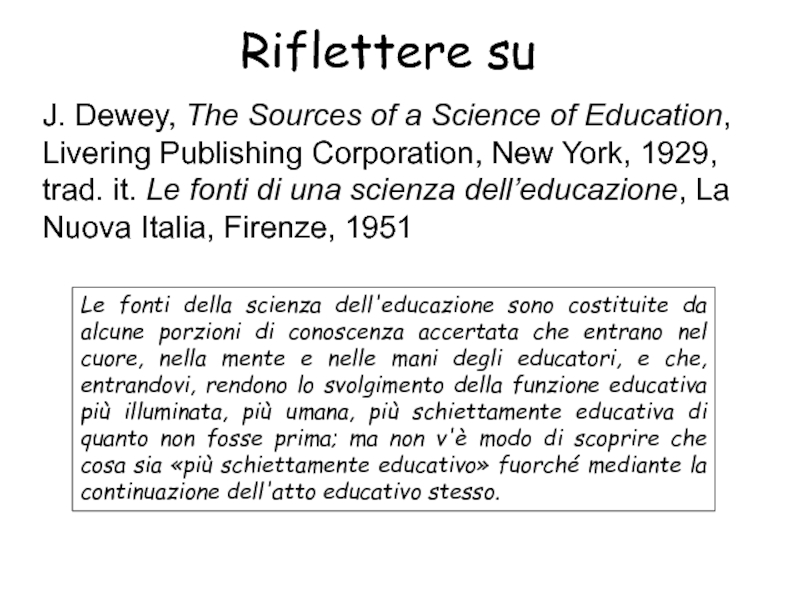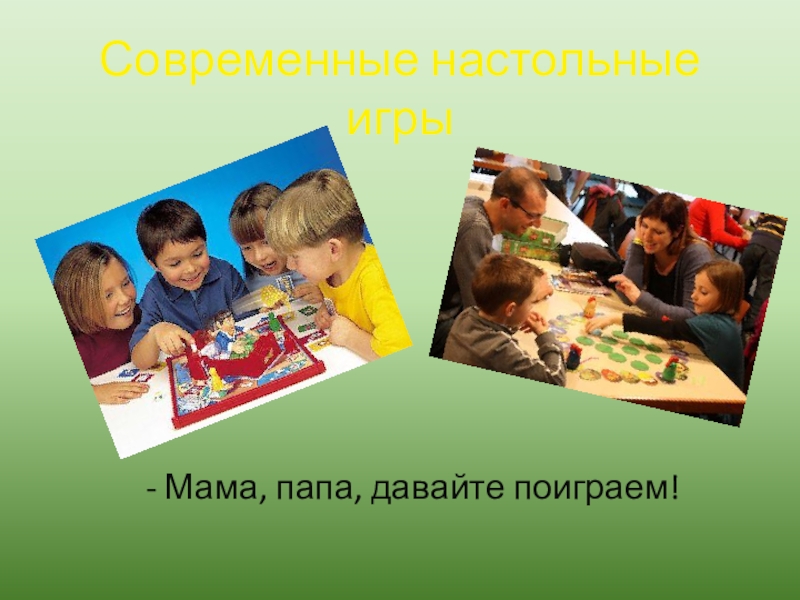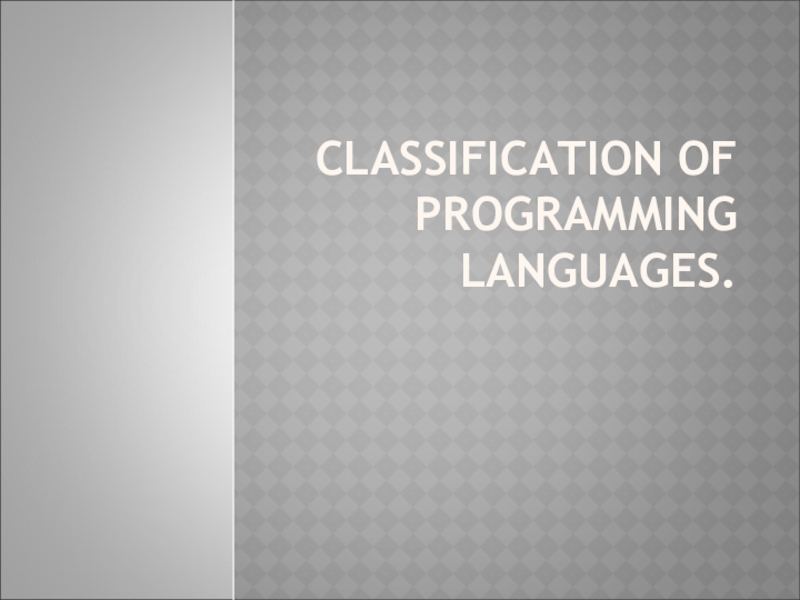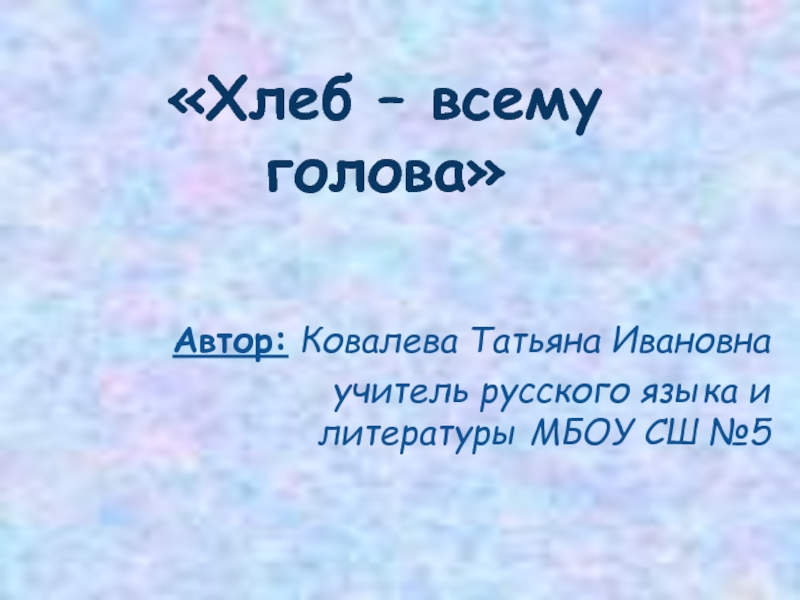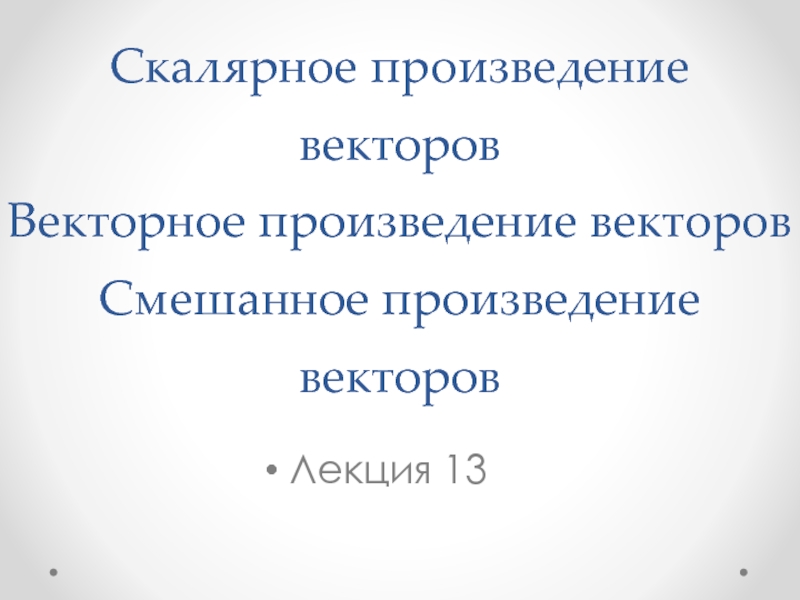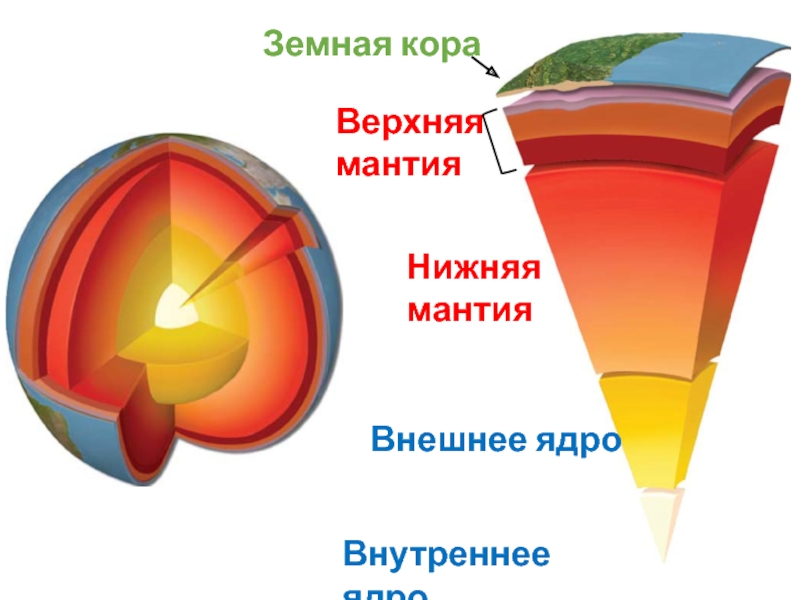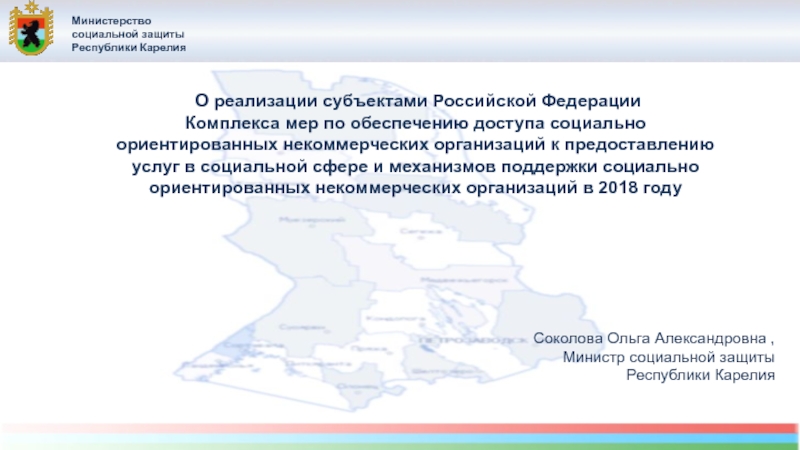Слайд 1Practise 4
Human Computer Interaction
Слайд 2Plan:
1. User interface as means of human-computer interaction. Usability
of interfaces.
2. Types of interfaces: command line interface, text interface,
graphic interface.
3. Physical and mental characteristics of the user. Development stages of the user interface. Types of testing of interfaces. Perspectives of development of interfaces.
4. Number system.
Слайд 3Definition of HCI
Human-computer interaction is a discipline concerned with the
design, evaluation and implementation of interactive computing systems for human
use and with the study of major phenomena surrounding them.
ACM SIGCHI Curricula for HCI http://sigchi.org/cdg/cdg2.html
Слайд 4Why HCI is Important
The study of our interface with information.
It
is not just ‘how big should I make buttons’ or
‘how to layout menu choices’
It can affect
Effectiveness
Productivity
Morale
Safety
Example: a car with poor HCI
Take 5 minutes for everyone to write down one common device with substantial HCI design choices and discuss with the neighbor the pros and cons. How does it affect you or other users?
Слайд 5What fields does HCI cover?
Computer Science
Psychology (cognitive)
Communication
Education
Anthropology
Design (e.g. graphic and
industrial)
Слайд 6HCI Community
Academics/Industry Research
Taxonomies
Theories
Predictive models
Experimenters
Empirical data
Product design
Other areas (Sociologists,
anthropologists, managers)
Motor
Perceptual
Cognitive
Social, economic, ethics
Слайд 7Usability Requirements
Goals:
Usability
Universality
Usefulness
Achieved by:
Planning
Sensitivity to user needs
Devotion to requirements analysis
Testing
Слайд 8Ascertain User’s Needs
Define tasks
Tasks
Subtasks
Frequency
Frequent
Occasional
Exceptional
Repair
Ex. difference between a space satellite, car
engine, and fighter jet
Слайд 9Reliability
Actions function as specified
Data displayed must be correct
Updates done correctly
Leads
to trust! (software, hardware, information) – case: Pentium floating point
bug
Privacy, security, access, data destruction, tampering
Слайд 10Standardization, Integration, Consistency, Portability
Standardization – common user-interface features across multiple
applications
Apple
Web
Windows
Integration – across application packages
file formats
Consistency – common action sequences,
terms, units, layouts, color, typography within an application
Portability – convert data and interfaces across multiple hardware and software environments
Word/HTML/PDF/ASCII
Слайд 11Usability Motivations
Life-Critical systems
Applications: air traffic, nuclear reactors, military, emergency dispatch
Requirements:
reliability and effective (even under stress)
Not as important: cost, long
training, satisfaction, retention
Industrial and Commercial Use
Applications: banking, insurance, inventory, reservations
Requirements: short training, ease of use/learning, multiple languages, adapt to local cultures, multiplatform, speed
Office, Home, and Entertainment
Applications: E-mail, ATMs, games, education, search engines, cell phones/PDA
Requirements: Ease of learning/use/retention, error rates, satisfaction
Difficulties: cost, size
Time to learn
Speed of performance
Rate of errors
Retention over time
Subjective satisfaction
Слайд 12Usability Motivations
Exploratory, Creative, Collaborative
Applications: Web browsing, search engines, simulations, scientific
visualization, CAD, computer graphics, music composition/artist, photo arranger (email photos)
Requirements:
remove the ‘computer’ from the experience,
Difficulties: user tech savvy-ness (apply this to application examples)
Socio-technical systems
Applications: health care, voting, police
Requirements: Trust, security, accuracy, veracity, error handling, user tech-savy-ness
Time to learn
Speed of performance
Rate of errors
Retention over time
Subjective satisfaction
Слайд 13Children
Technology saviness?
Age changes much:
Physical dexterity
(double-clicking, click and drag, and
small targets)
Attention span
(vaguely) Intelligence
Varied backgrounds (socio-economic)
Goals
Educational acceleration
Socialization with peers
Psychological -
improve self-image, self-confidence
Creativity – art, music, etc. exploration
Слайд 14Children
Teenagers are a special group
Next generation
Beta test new interfaces, trends
Cell
phones, text messages, simulations, fantasy games, virtual worlds
Requires Safety
They
Like exploring
(easy to reset state)
Don’t mind making mistakes
Like familiar characters and repetition (ever had to babysit a kid with an Ice Age DVD?)
Don’t like patronizing comments, inappropriate humor
Design: Focus groups
Слайд 15Accommodating Hardware and Software Diversity
Support a wide range of hardware
and software platforms
Software and hardware evolution
OS, application, browsers, capabilities
backward compatibility
is a good goal
Three major technical challenges are:
Producing satisfying and effective Internet interaction (broadband vs. dial-up & wireless)
Enabling web services from large to small (size and resolution)
Support easy maintenance of or automatic conversion to multiple languages
Слайд 16HCI Goals
Influence academic and industrial researchers
Understand a problem and related
theory
Hypothesis and testing
Study design (we’ll do this!)
Interpret results
Provide tools, techniques
and knowledge for commercial developers
competitive advantage (think ipod)
Raising the computer consciousness of the general public
Reduce computer anxiety (error messages)
Common fears:
I’ll break it
I’ll make a mistake
The computer is smarter than me
HCI contributes to this!
Слайд 17Human–computer interaction (commonly referred to as HCI)
researches the design
and use of computer technology, focused on the interfaces between
people (users) and computers. Researchers in the field of HCI both observe the ways in which humans interact with computers and design technologies that let humans interact with computers in novel ways.
Слайд 18Humans interact with computers in many ways; and the interface
between humans and the computers they use is crucial to
facilitating this interaction. Desktop applications, internet browsers, handheld computers, and computer kiosks make use of the prevalent graphical user interfaces (GUI) of today.
Слайд 19 The human–computer interface can be described as the point
of communication between the human user and the computer. The
flow of information between the human and computer is defined as the loop of interaction.
Слайд 20The loop of interaction has several aspects to it, including:
Visual
Based :The visual based human computer inter-action is probably the most
widespread area in HCI research.
Audio Based : The audio based interaction between a computer and a human is another important area of in HCI systems. This area deals with information acquired by different audio signals.
Слайд 21The loop of interaction has several aspects to it, including:
Task
environment: The conditions and goals set upon the user.
Machine environment:
The environment that the computer is connected to, e.g. a laptop in a college student's dorm room.
Areas of the interface: Non-overlapping areas involve processes of the human and computer not pertaining to their interaction. Meanwhile, the overlapping areas only concern themselves with the processes pertaining to their interaction.
Слайд 22The loop of interaction has several aspects to it, including:
Input
flow: The flow of information that begins in the task
environment, when the user has some task that requires using their computer.
Output: The flow of information that originates in the machine environment.
Слайд 23The loop of interaction has several aspects to it, including:
Feedback:
Loops through the interface that evaluate, moderate, and confirm processes
as they pass from the human through the interface to the computer and back.
Fit: This is the match between the computer design, the user and the task to optimize the human resources needed to accomplish the task.
Слайд 242. Types of interfaces: command line interface, text interface, graphic
interface.
There exist several types of user interfaces.
Command-Line Interface (CLI):
The user provides the input by typing a command string with the computer keyboard and the system provides output by printing text on the computer monitor .
Слайд 25Fig 1. A Command Line Interface.
Слайд 26Text interface with menus
A text interface can be made easier
to navigate using menus created with text and ASCII extended
characters. For example, many command line text editors have some type of interface with menus and shortcut keys that make navigating the file being edited easier.
Слайд 27WIMP or GUI Interface
A graphical user interface (GUI) is the
most common type of user interface in use today. It
is a very 'friendly' way for people to interact with the computer because it makes use of pictures, graphics and icons - hence why it is called 'graphical'.
A GUI (pronounced gooey) is also known as a WIMP interface because it makes use of: Windows, Icons, Menus, Pointers.
Слайд 283. Physical and mental characteristics of the user. Development stages
of the user interface. Types of testing of interfaces (testing
of users). Perspectives of development of interfaces.
The system that people use to interact with a computer (to give it commands, to see the results of those commands, etc.) is known as the user interface.
Слайд 29Graphical user interface
In computer science, a graphical user interface, is
a type of user interface that allows users to interact
with electronic devices through graphical icons and visual indicators such as secondary notation, instead of text-based user interfaces, typed command labels or text navigation.
Слайд 30Post-WIMP interfaces
Smaller mobile devices such as personal digital assistants (PDAs)
and smartphones typically use the WIMP elements with different unifying
metaphors, due to constraints in space and available input devices.
Слайд 31Operating system command-line interfaces
A program that implements such a text
interface is often called a command-line interpreter, command processor or
shell.
Слайд 32Application command-line interfaces
Application programs (as opposed to operating systems) may
also have command line interfaces.
An application program may support none,
any, or all of these three major types of command line interface mechanisms.
Слайд 33Sound and speech interface
This type of interface allows the user
to speak or type in their normal everyday language in
order to interact with the computer.
